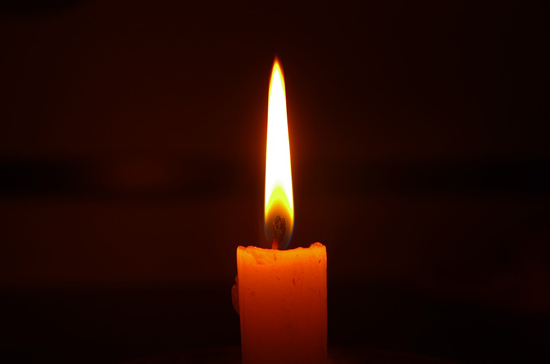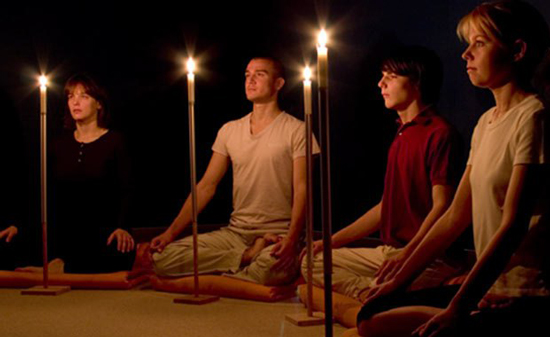TRATAKAM and the Amazing Benefits of Candle Gazing

The practice of candle gazing has a number of amazing benefits, including opening up your third eye (pineal gland), improved eyesight, focus, concentration and much more!
This simple technique is an excellent introduction to the art and science of meditation. People of all ages and stress levels can immediately feel the benefits. Students can use this before studying to improve their concentration.
What is TRATAKAM or Candle Gazing Meditation?
The secret of this technique lies in that you gaze at an object that captures your attention. Perhaps you have had the experience of being totally absorbed, taken outside yourself as it were by a magnificent sunset, stopped and held in the moment by something of exquisite beauty and in that moment you entered the timeless, catching a glimpse of eternity.
This candle gazing technique, if practiced regularly, can hone and develop your concentration to the “enth” degree, as it brings the mind to a place of stillness. Distractions dissolve away, and the mind becomes focused on the flame. The candle gazing meditation also improves memory bringing the mind to awareness.
Translating as to “gaze” or “look”, TRATAKAM, the concentration technique of gazing at an object of your choice, is a favorite of many yoga students. It is successfully used as preparation before doing meditation. If you are only doing HATHA YOGA, you are not experiencing the full magic and richness of the science and art of yoga.
TRATAKAM technique with a candle
– Light a candle and place it on a small table around 3 to 4 feet in front of you.
– Sit in a comfortable posture with the spine upright and the arms and shoulders relaxed. You can assume any meditative posture which you can maintain without any movement for the duration of the TRATAKAM practice.
– Make sure that the flame is at the level of your eyes. Also, make sure that you are facing the candle directly without having to turn the neck even slightly.
– It is important that the flame remains steady during the concentration routine. So, make sure that there no breeze around of any kind to disturb the flame. If needed, turn off any fans or air conditioner in the room.
– Take a few deep breaths to relax. Close the eyes and watch your breath as you inhale and exhale for about five to seven breaths. This will allow the breath to settle down and bring you into the present moment.
– Now, gaze at the flame intently and keep your gaze on it without getting distracted towards outer disturbances and thoughts.
– Keep your vision focused and steady on the flame without blinking, for as long as it is comfortable to you. Try to avoid any kind of body movement during the entire practice.
– Keep your gaze anchored on some part of the flame, rather than the candle or wick. If thoughts come up in the mind, just become aware of them and then ignore them. Pursue to maintain your awareness and focus on the flame.
– Continue to gaze at the flame until you cannot keep your eyes open. Once this happens, close your eyes.
– When you close the eyes, you may be able to visualize an after-image of the flame with closed eyes. Pursue to bring this image at the point between the eyebrows at the center of the forehead (the third eye location).
– The depth and level of your concentration will determine how clear the after-image is. If you cannot visualize the after-image of the flame with closed eyes, or it wavers constantly or loses clarity, then re-apply your concentration to restore the position of the after-image.
– When the image begins to fade out completely, bring your awareness back to your breathing and begin to watch the flow of breath at the tip of the nose for about 7 to 8 breaths.
– You can open your eyes at this point and repeat the full gazing routine as given above one more time.
Benefits of TRATAKAM

Shloka 2.32 of the HATHA YOGA PRADIPIKA states “TRATAKAM eradicates all eye diseases, fatigue and sloth and closes the doorway to these problems”.
Some of the benefits associated with TRATAKAM are:
– Improves eyesight and vision.
– Improves concentration, intelligence and memory.
– Excellent method as preparation for LAYA YOGA meditation.
– Enhances self-confidence, patience and willpower.
– Develops greater work efficiency and productivity.
– Calms the mind and provides inner peace and silence.
– Brings greater clarity in mind and improves decision-making ability.
– Helps to overcome mental, behavioral and emotional ailments.
– Provides stress relief and deep relaxation.
– Deepens the sleep and cures sleep related disorders such as headache, insomnia, nightmares, etc.
– According to GHERANDA SAMHITA (shloka 5.54), TRATAKAM promotes clairvoyance or perception of subtle manifestations.
Tips for TRATAKAM Concentration
– TRATAKAM is best practiced on an empty stomach during early-morning hours or late evening hours just before going to bed. If you practice it during the daytime, make sure that the room is dark so that focusing on the flame is easier.
– Try getting a decent sized flame by adjusting the size of the wick. It will help in achieving a better after-image of the flame and it will be easier to visualize it with improved concentration.
– Do not strain your eyes while gazing on the flame. The eyes adjust naturally in due course of time and it becomes easier to concentrate and gaze on the flame for longer periods of time.
– Because TRATAKAM develops deep focus and concentration, it is used as a very effective pre-meditation stage. At the end of the TRATAKAM routine, you may continue with your own LAYA YOGA meditation.
This technique was used by the ancient priestesses in Egypt, gazing into a bowl of still-water.
Two techniques of TRATAKAM are offered by the yogi sages: Bahiranga – outer gazing and Antranga – inward gaze. The technique of outer gazing further develops your spiritual powers.
The physical side effects are an improvement or correction for short sightedness.
It has the wonderful effect of calming your mind, removing anxiety, by bringing a stilling of the mind so that a wondrous relaxation steals over your whole body.
Shanti Gowans in her book Calm the Mind tells us: “This training in one pointedness of the mind is the first step in learning not to cling. The goal of meditation is to free awareness from its identification with your senses and thoughts. So freed awareness permeates everything but clings to nothing. So practice one-pointedness (TRATAKAM) and the exclusion of all other considerations, even when these considerations happen to be enticing.”
Shanti also says: “The eyes are doorways to the mind, and intimately related to it. When the eyes are fixed and unmoving, the mind also becomes the same and the thinking process automatically ceases as concentration increases and deepens.”
How does it work?
Sit with a straight spine, position the candle close to you. (If you are teaching in a class sit students in a circle around the candle leveled with their gaze.)
As the candle flame stills, so will your breath and mind. Gaze for a few minutes at the flame, at the golden glow above the wick. Rest your eyes on the golden white light, now blow out the flame, close your eyes and await the image that will appear on the inside of your eyelids. Do not worry if nothing appears, sit with the no-image, the blank screen of your mind.
We are not all visual people, but practicing this technique will improve that sense. After a while the image will fail.
To lift this technique to another level: Take your mind back to the time when the candle was newly lit. See it again in your mind’s eye. The candle, the black wick, the brilliant golden white light surrounded by a subtle halo or aura. Picture this halo as expanding, your soft breathing is feeding the expansion so now your point of focus is the candle flame. Hold this until it fades. Slowly bring back your attention into the room.
yogaesoteric
September 15, 2018
